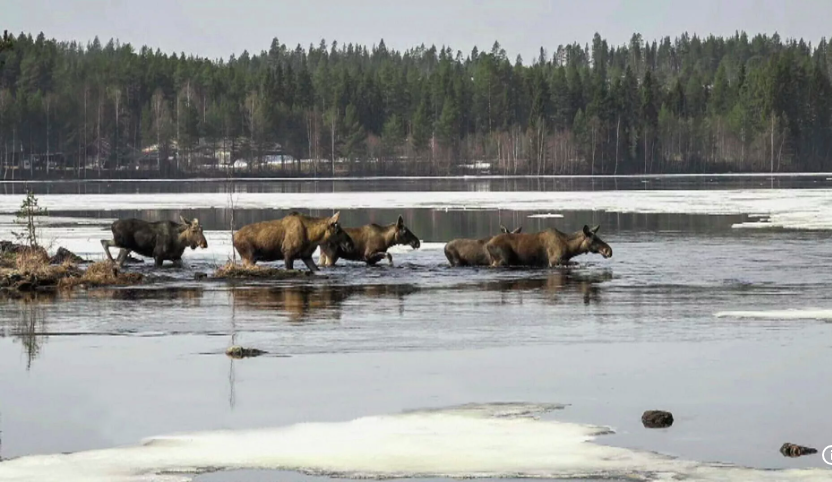Sweden’s Great Moose Migration Draws 9 Million Viewers as Slow TV Captivates the World
Quote from Alex bobby on April 15, 2025, 6:51 AM
Title: Sweden’s Slow TV Sensation: “The Great Moose Migration” Captivates 9 Million Viewers
In an age of rapid scrolling and binge-worthy thrillers, a 24-hour livestream of moose migrating through the Swedish wilderness is drawing in millions of viewers—and changing how people connect with nature and media. “The Great Moose Migration” (or Den stora älgvandringen), now in its sixth year, has evolved into a national phenomenon. In 2024, the show hit a record 9 million viewers on SVT Play, Sweden’s national streaming platform.
For 62-year-old super-fan Ulla Malmgren, watching the livestream has become more than a hobby—it’s a lifestyle. “Sleep? Forget it. I don’t sleep,” she joked, having stocked up on coffee and snacks to stay glued to the screen for the entire 20-day event.
A Migration Like No Other
Each spring, dozens of moose cross the Ångerman River, about 300 kilometres northwest of Stockholm, as they head toward their summer grazing grounds. Their route—used for thousands of years—is now monitored by 26 remote-controlled cameras and 7 night vision cameras, all feeding footage back to SVT’s control room in Umeå. A drone provides sweeping aerial shots, while nearly 20,000 meters of cable ensures seamless coverage of the forest and riverbank.
Despite its slow pace and hours-long stretches of quiet forest views, the show offers moments of suspense. Viewers wait eagerly for alerts like “Första älgarna i bild!” (“First moose on camera!”) to pop up, and when one finally appears, the chat room erupts with encouragement: “Go on! Yes, you can do it!”
More Than Just a Show
SVT project manager Johan Erhag says the production has a unique calming effect—both on the crew and the audience. “Everyone who works with it goes down in their normal stress,” he explained. The natural rhythm of the moose migration contrasts sharply with the fast pace of daily life, offering viewers a moment of peace and mindfulness.
“It’s gripping because nothing catastrophic is happening, nothing spectacular is happening,” said Annette Hill, professor of media and communications at Jönköping University. “But something very beautiful is happening in that minute-by-minute moment.”
The slow TV trend began with Norwegian broadcaster NRK’s seven-hour train ride broadcast in 2009 and has since spread to countries like the UK, China, and the Netherlands, where a “fish doorbell” livestream lets viewers alert authorities when fish are blocked during their migration.
Bringing the Wild Into the Living Room
Moose are considered “Kings of the Forest” in Sweden, yet sightings in the wild are rare. “You often see it when you’re out driving maybe once or twice in your life,” said Erhag. “That’s one reason why it has been so popular. You bring nature into everyone’s living room.”
With some 300,000 moose roaming Swedish forests, their majestic size and elusive nature make them endlessly fascinating to viewers like 20-year-old William Garp Liljefors, who has collected over 150 moose plush toys since becoming a fan. “I feel relaxed, but at the same time I’m like, ‘Oh, there’s a moose, oh! What if there’s a moose? I can’t go to the toilet!’” he said.
For 36-year-old Hanna Sandberg, the show’s appeal lies in its intimacy with the animals. “You can watch them and be a part of their natural habitat in a way that you could never be otherwise,” she said.
A Community of Moose Mega-Fans
The fanbase is deeply loyal. A Facebook group dedicated to the migration now boasts over 76,000 members. Some viewers rearrange their lives around the broadcast. “I was late to school because I saw moose,” said Liljefors. “My teacher was like, ‘What, you saw moose in the city?’ And I was like, ‘No, it’s on the TV.’”
Malmgren has trained her family not to interrupt her during the migration. “When someone asks me, ‘What are you doing?’ Oh, never mind, it’s the great migration,” she said. “They know.”
Conclusion
“The Great Moose Migration” proves that compelling television doesn’t need to be fast-paced or heavily produced. In a time when people are overwhelmed by screens, deadlines, and notifications, this quite Swedish production offers a rare invitation to slow down, connect with nature, and simply watch. As the moose move gracefully across the river, millions of viewers from around the world are reminded that sometimes, the best stories unfold one careful step at a time.

Title: Sweden’s Slow TV Sensation: “The Great Moose Migration” Captivates 9 Million Viewers
In an age of rapid scrolling and binge-worthy thrillers, a 24-hour livestream of moose migrating through the Swedish wilderness is drawing in millions of viewers—and changing how people connect with nature and media. “The Great Moose Migration” (or Den stora älgvandringen), now in its sixth year, has evolved into a national phenomenon. In 2024, the show hit a record 9 million viewers on SVT Play, Sweden’s national streaming platform.
For 62-year-old super-fan Ulla Malmgren, watching the livestream has become more than a hobby—it’s a lifestyle. “Sleep? Forget it. I don’t sleep,” she joked, having stocked up on coffee and snacks to stay glued to the screen for the entire 20-day event.
Register for Tekedia Mini-MBA edition 17 (June 9 – Sept 6, 2025) today for early bird discounts. Do annual for access to Blucera.com.
Tekedia AI in Business Masterclass opens registrations.
Join Tekedia Capital Syndicate and co-invest in great global startups.
Register to become a better CEO or Director with Tekedia CEO & Director Program.
A Migration Like No Other
Each spring, dozens of moose cross the Ångerman River, about 300 kilometres northwest of Stockholm, as they head toward their summer grazing grounds. Their route—used for thousands of years—is now monitored by 26 remote-controlled cameras and 7 night vision cameras, all feeding footage back to SVT’s control room in Umeå. A drone provides sweeping aerial shots, while nearly 20,000 meters of cable ensures seamless coverage of the forest and riverbank.
Despite its slow pace and hours-long stretches of quiet forest views, the show offers moments of suspense. Viewers wait eagerly for alerts like “Första älgarna i bild!” (“First moose on camera!”) to pop up, and when one finally appears, the chat room erupts with encouragement: “Go on! Yes, you can do it!”
More Than Just a Show
SVT project manager Johan Erhag says the production has a unique calming effect—both on the crew and the audience. “Everyone who works with it goes down in their normal stress,” he explained. The natural rhythm of the moose migration contrasts sharply with the fast pace of daily life, offering viewers a moment of peace and mindfulness.
“It’s gripping because nothing catastrophic is happening, nothing spectacular is happening,” said Annette Hill, professor of media and communications at Jönköping University. “But something very beautiful is happening in that minute-by-minute moment.”
The slow TV trend began with Norwegian broadcaster NRK’s seven-hour train ride broadcast in 2009 and has since spread to countries like the UK, China, and the Netherlands, where a “fish doorbell” livestream lets viewers alert authorities when fish are blocked during their migration.
Bringing the Wild Into the Living Room
Moose are considered “Kings of the Forest” in Sweden, yet sightings in the wild are rare. “You often see it when you’re out driving maybe once or twice in your life,” said Erhag. “That’s one reason why it has been so popular. You bring nature into everyone’s living room.”
With some 300,000 moose roaming Swedish forests, their majestic size and elusive nature make them endlessly fascinating to viewers like 20-year-old William Garp Liljefors, who has collected over 150 moose plush toys since becoming a fan. “I feel relaxed, but at the same time I’m like, ‘Oh, there’s a moose, oh! What if there’s a moose? I can’t go to the toilet!’” he said.
For 36-year-old Hanna Sandberg, the show’s appeal lies in its intimacy with the animals. “You can watch them and be a part of their natural habitat in a way that you could never be otherwise,” she said.
A Community of Moose Mega-Fans
The fanbase is deeply loyal. A Facebook group dedicated to the migration now boasts over 76,000 members. Some viewers rearrange their lives around the broadcast. “I was late to school because I saw moose,” said Liljefors. “My teacher was like, ‘What, you saw moose in the city?’ And I was like, ‘No, it’s on the TV.’”
Malmgren has trained her family not to interrupt her during the migration. “When someone asks me, ‘What are you doing?’ Oh, never mind, it’s the great migration,” she said. “They know.”
Conclusion
“The Great Moose Migration” proves that compelling television doesn’t need to be fast-paced or heavily produced. In a time when people are overwhelmed by screens, deadlines, and notifications, this quite Swedish production offers a rare invitation to slow down, connect with nature, and simply watch. As the moose move gracefully across the river, millions of viewers from around the world are reminded that sometimes, the best stories unfold one careful step at a time.
Uploaded files:


